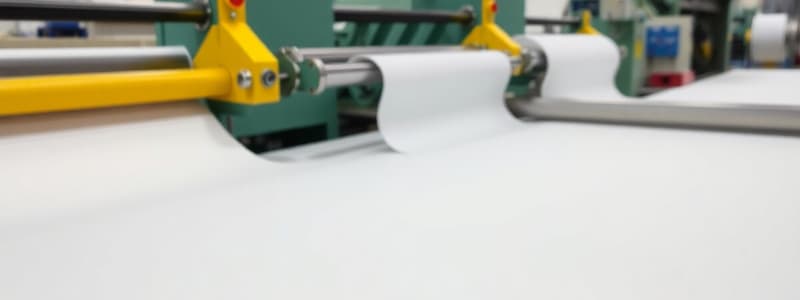Podcast
Questions and Answers
What is the primary advantage of on-machine calendering over off-machine calendering?
What is the primary advantage of on-machine calendering over off-machine calendering?
- It is more cost-effective and utilizes current technology. (correct)
- It is faster than off-machine calendering.
- It produces thicker paper more efficiently.
- It requires less energy to operate.
How many sets of rolls can high-grade finishing involve during the calendering process?
How many sets of rolls can high-grade finishing involve during the calendering process?
- Up to 5 sets of rolls.
- Only one set of rolls.
- Only two sets of rolls.
- Up to 3 sets of rolls. (correct)
What distinguishes the soft-nip machine calender from the hard-nip machine calender?
What distinguishes the soft-nip machine calender from the hard-nip machine calender?
- The soft-nip calender has a soft roll layer made of elastic material. (correct)
- The soft-nip calender uses hard metal rolls.
- The soft-nip calender creates thicker paper.
- The soft-nip calender is less commonly used.
Which factor influences the calendering level required for a specific type of paper?
Which factor influences the calendering level required for a specific type of paper?
What is one of the methods used to heat the rolls in an intermediate rolls stack during calendering?
What is one of the methods used to heat the rolls in an intermediate rolls stack during calendering?
What is a major advantage of soft-nip calendering?
What is a major advantage of soft-nip calendering?
Which statement is true about supercalenders?
Which statement is true about supercalenders?
What is a drawback of using soft rolls in supercalenders?
What is a drawback of using soft rolls in supercalenders?
How does blackening affect the printing quality of paper?
How does blackening affect the printing quality of paper?
What process takes place after drying and calendering paper?
What process takes place after drying and calendering paper?
What is the primary function of the driving drum in the reeling process?
What is the primary function of the driving drum in the reeling process?
During the reeling process, what happens as pressure is applied by the secondary arms?
During the reeling process, what happens as pressure is applied by the secondary arms?
What is the most common defect encountered during the reeling process?
What is the most common defect encountered during the reeling process?
What role do the secondary arms play after the desired diameter of the paper reel is reached?
What role do the secondary arms play after the desired diameter of the paper reel is reached?
What is the typical diameter range for a reel spool used in the reeling process?
What is the typical diameter range for a reel spool used in the reeling process?
What is the primary objective of the calendering process in papermaking?
What is the primary objective of the calendering process in papermaking?
Which part of the calender stack consists of heated rolls and variable-crown rolls?
Which part of the calender stack consists of heated rolls and variable-crown rolls?
What does the calendering section control in addition to smoothing the watermark on paper?
What does the calendering section control in addition to smoothing the watermark on paper?
What is true about the time taken for pressing in the calendering process?
What is true about the time taken for pressing in the calendering process?
Which rolls are usually considered the driven rolls in the calender stack?
Which rolls are usually considered the driven rolls in the calender stack?
Flashcards
Calendering
Calendering
A process that involves passing paper through a series of pressurized rolls, reducing its thickness and achieving a smooth surface.
Calender stack
Calender stack
Solid rolls used in calendering, typically made of steel or cast iron.
Intermediate rolls
Intermediate rolls
Rolls that are neither the top nor bottom rolls in a calender stack.
Queen rolls
Queen rolls
Signup and view all the flashcards
King rolls
King rolls
Signup and view all the flashcards
Calendering Level
Calendering Level
Signup and view all the flashcards
On-Machine vs. Off-Machine Calendering
On-Machine vs. Off-Machine Calendering
Signup and view all the flashcards
Soft-Nip Machine Calender
Soft-Nip Machine Calender
Signup and view all the flashcards
Hard-Nip Machine Calender
Hard-Nip Machine Calender
Signup and view all the flashcards
Reeling
Reeling
Signup and view all the flashcards
Driving Drum
Driving Drum
Signup and view all the flashcards
Reel Spool
Reel Spool
Signup and view all the flashcards
Primary and Secondary Arms
Primary and Secondary Arms
Signup and view all the flashcards
Full Reel
Full Reel
Signup and view all the flashcards
Supercalendering
Supercalendering
Signup and view all the flashcards
Soft Rolls
Soft Rolls
Signup and view all the flashcards
Hard Rolls
Hard Rolls
Signup and view all the flashcards
Machine Calendering
Machine Calendering
Signup and view all the flashcards
Study Notes
IWK 203/4: Stock Preparation and Papermaking
- Course code: IWK 203/4
- Course title: Stock Preparation and Papermaking
- Also known as: Penyediaan Stok & Pembuatan Kertas (Malay)
- Instructor: Dr. Kushairi Mohd Salle
- Institution: Universiti Sains Malaysia
- Academic year: 2024/2025
Papermaking Sections
- Introduction to Papermaking (2.1)
- Approach Flow System (2.2)
- Forming Section (2.3)
- Pressing Section (2.4)
- Drying Section (2.5)
- Calendering, Reeling, and Finishing Sections (2.6)
Calendering, Reeling, and Finishing Sections (2.6)
-
Calendering:
- After drying, most paper grades pass through calendering.
- Calendering uses rolls to press the paper under high pressure.
- The calender stack consists of horizontal rolls (steel or cast iron) stacked vertically.
- The objectives of calendering are to reduce paper thickness and create a smooth surface.
- Calendering is also used to control paper density and smooth watermarks.
- Rolls may not have equal hardness. Nip pressing time is shorter.
- Calendering level depends on desired finishing grade.
- Low-grade paper requires only one or two nips. High-grade paper may pass through several sets (7-9 rolls per set).
-
Rolls:
- Intermediate rolls (upper stack): Heated rolls and variable-crown rolls.
- Queen rolls: Usually driven rolls.
- King rolls (bottom): Act as variable rolls.
-
Types of Calenders (and types of rolls):
- On-machine calenders are more economic.
- High temperature calendering allows for lower pressure. Frequently first two rolls are heated by hot water.
- Tri-pass drilled rolls are most efficient. Shell rolls are efficient. Bored rolls are least efficient.
- Machine calenders use a hard-nip system (pair of hard metal rolls) to produce uniform thickness.
-
Reeling:
- Post-drying and calendering, paper is collected on a metal cylinder (reel spool).
- Reeling gathers paper from the paper machine and forms a loop (full reel).
- On-machine reeling happens after calendering. Off-machine reeling happens before calendering.
- Key components: driving drum/reel drum, reel spool, primary arm, secondary arm.
-
Reeling process details:
- Driver drum is the most important component as it controls the speed.
- Reel spool is initially positioned in the primary arms, then the secondary arms apply pressure for wrapping.
- Reeling stops upon reaching the desired diameter (full reel).
- Reeling is stopped, the paper is broken, and the full reel is moved to the end of the rail.
-
Winding:
- Post-reeling, the paper travels through a winding stage.
- Purpose: Cut and wind the full reel into smaller, usable rolls.
-
Size press: Size press distributes sizing agents (like starch) on paper, improving water and air permeability to strengthen the paper.
-
Pigment coatings:
- Improve the sheet's surface for printing by mixing fillers and binders with the paper.
-
Modern Paper Machine Finishing:
-
Now finishing is done on machine.
-
Paper Coating Principles:
- Blade coating, Size press, Film coating, Curtain coating, Spray coating.
-
Blade coating produces smooth but uneven coatings. Curtain coating produces even but rough coatings.
Additional Information
- Typical reeling defect: wrinkles and breaks due to air pockets, especially in dense/low porosity paper.
- Winding process trims both edges of the paper. Broke is recycled. The middle is cut depending on the width.
- Paper rolls are marked with details like grammage, thickness, and width.
- Paper rolls are sent for further treatment to produce additional paper products.
Studying That Suits You
Use AI to generate personalized quizzes and flashcards to suit your learning preferences.




